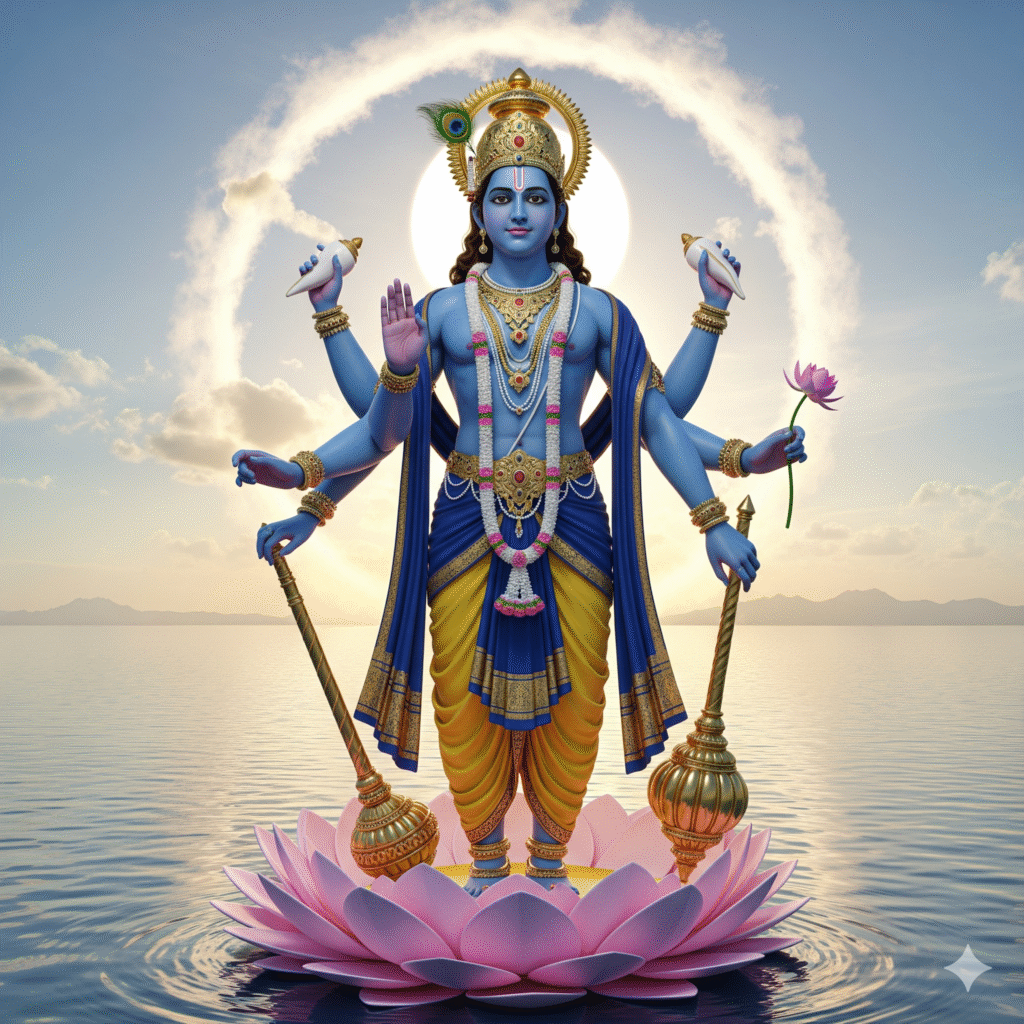
Lord Vishnu: Preserver of the Universe and Protector of Dharma
Lord Vishnu is one of the main trinity of Hinduism. He is the Preserver of the Universe. Shiva is the destroyer and Brahma is the creator, while Vishnu’s job is to nurture and maintain balance in the world.
Lord Vishnu is worshipped as a symbol of peace, compassion and establishment of Dharma.
Form and symbol of Lord Vishnu
The divine form of Lord Vishnu is extremely attractive and powerful.
- The colour of his body is said to be blue (deep blue like the sea).
- He has four hands, in which
o Shankh (Panchajanya)
o Chakra (Sudarshan Chakra)
o Gada (Kaumodaki)
o Padma (Lotus)
- His vehicle is Garuda and Sheshnag is his sleeping partner.
- ____________________________
Ten incarnations of Lord Vishnu (Dashavatara)
Lord Vishnu takes incarnation on earth from time to time to protect religion and destroy unrighteousness. These are called Dashavatara –
- Matsya incarnation
In the form of a fish to save the world from the deluge. - Kurma incarnation
In the form of a turtle to support Mount Mandarachal during the churning of the ocean. - Varaha incarnation
In the form of a boar to save the earth from Hiranyaksha. - Narasimha incarnation
In the form of a half lion and half human to protect devotee Prahlad from the atrocities of Hiranyakashipu. - Vaman incarnation
In the form of a dwarf Brahmin to free the earth from King Bali. - Parashurama incarnation
In the form of Parashurama to destroy the tyrannical Kshatriyas. - Lord Rama
In Treta Yuga to kill Ravana and establish dignity. - Lord Krishna
Killed Kansa in Dwapar Yuga and established Dharma in Mahabharata.
- Buddha Avatar
Buddha form to give the message of non-violence and compassion.
- Kalki Avatar
Will appear at the end of Kaliyuga and destroy Adharma.
Worship and Importance of Lord Vishnu
Vishnu Ji’s Worship Method
- Meditate on Lord Vishnu after purifying yourself in the morning.
- Offer Tulsi leaves, yellow flowers and incense sticks.
- Chant the mantra “Om Namo Bhagwate Vasudevay”.
Importance of Vishnu Ji
- Provides peace and prosperity to the devotees.
- Inspires to maintain Dharma, truth and balance in life.
- The stories of his incarnations teach how to live life.
Conclusion
Lord Vishnu is not only the protector of Dharma, but is also a symbol of devotion, compassion and peace. His incarnations tell us that whenever unrighteousness prevails in the world, God himself descends on earth and protects righteousness.
Introduction to Lord Vishnu
Lord Vishnu is one of the Tridev (Brahma, Vishnu and Mahesh) of Hinduism. His job is to nurture and protect the universe. While Brahma creates the universe and Shiva destroys it, Lord Vishnu maintains the balance of the world.
He is worshipped as the protector, protector of religion and the ocean of compassion.
Lord Vishnu is known by various names, such as – Narayana, Hari, Janardan, Vasudev, Padmanabha and Jagannath.
Importance of Vishnu Ji
- He always takes incarnation to destroy the evil and establish the religion.
- He is a symbol of peace, prosperity and security for the devotees.
- By taking his name, man’s sins are removed and salvation is attained.
Description in Puranas
Vishnu Ji is described in texts like Rigveda, Mahabharata, Bhagwat Purana and Vishnu Purana. In these, he is described as infinite, omnipresent and the protector of the universe.
Form and Symbol of Lord Vishnu
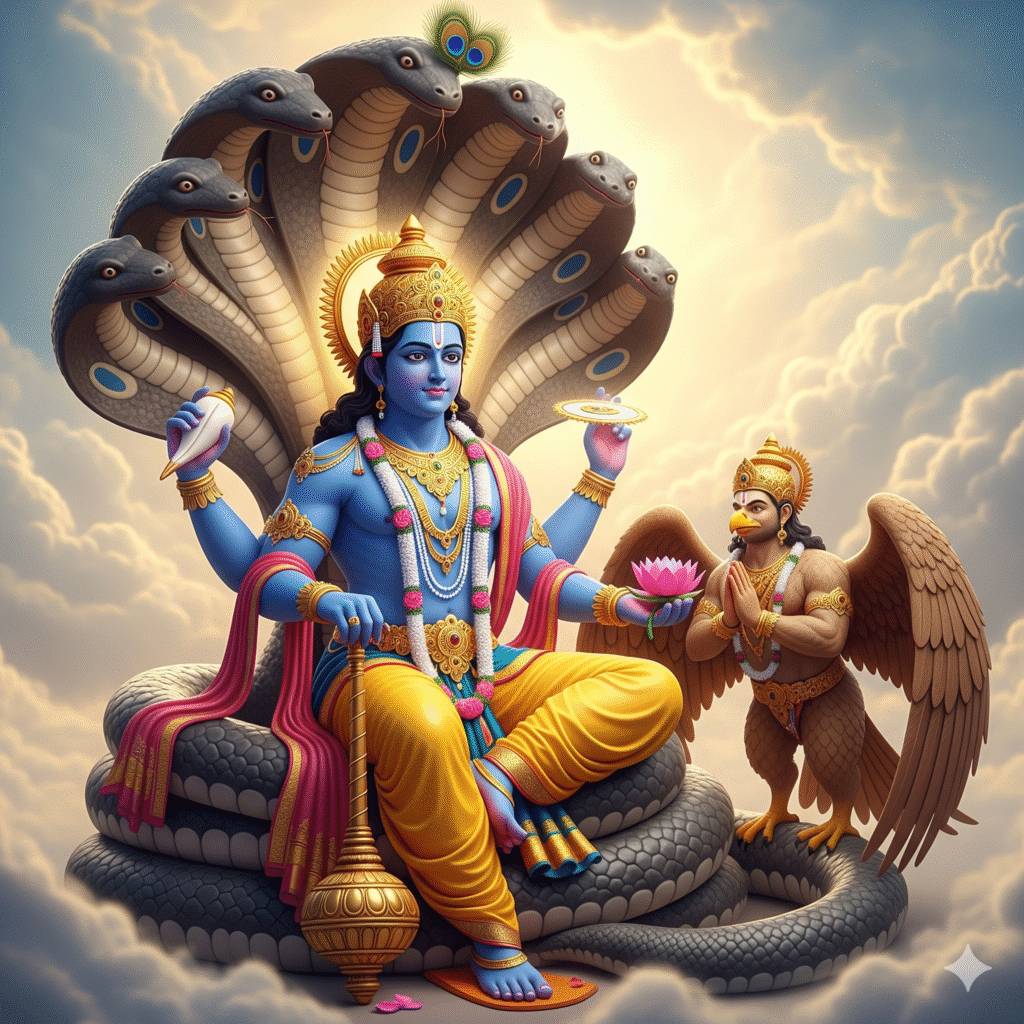
Lord Vishnu’s form is extremely divine, calm and compassionate. In the scriptures, he is described as Neelvarn (dark blue), which symbolizes the infinity of the sky and the sea.
Lord Vishnu’s four hands
Lord Vishnu has four hands, in which he holds different divine weapons and symbols –
- Shankh (Panchajanya) – symbol of religion and purity.
- Sudarshan Chakra – symbol of destruction of Adharma and Asuras.
- Gada (Kaumodaki) – symbol of power and justice.
- Padma (Lotus) – symbol of purity, knowledge and creation.
Vehicle and seat of Lord Vishnu
- Lord Vishnu’s vehicle is Garuda (large bird), which is a symbol of courage and swiftness.
- He is often shown resting on Sheshnag, which is a symbol of eternity and stability.
Other symbols
- He has Kaustubha Mani studded around his neck, which is a precious gem. • His clothes are yellow in colour, which symbolizes peace, purity and devotion.
- Vishnu’s wife Mata Lakshmi resides on his chest in the form of the Shreevats symbol.
Ten incarnations of Lord Vishnu (Dashavatara)
According to Hindu religion, whenever adharma increased on earth and dharma came in danger, Lord Vishnu protected the world by taking different avatars. These avatars are called Dashavatara.
- Matsya avatar
At the time of deluge, Lord Vishnu took the form of a fish and took Manu and the Saptarishis to a safe place. He protected the Vedas. - Kurma avatar
At the time of Samudra Manthan, Lord Vishnu took the form of a tortoise and helped the gods and demons by supporting Mount Mandara on his back. - Varaha avatar
A demon named Hiranyaksha drowned the earth in the netherworld. Then Lord Vishnu took the form of Varaha (boar) and lifted the earth on his teeth and protected it. - Narasimha avatar
A demon named Hiranyakashipu tortured his devotee son Prahlad. Then Lord Vishnu took the form of half lion and half human and killed him and protected the devotee. - Vamana Avatar
A demon named Bali had taken over the three worlds. Lord Vishnu came in the form of Vamana (dwarf Brahmin) and asked for three steps of land. He measured the entire universe in three steps and sent Bali to the netherworld. - Parashurama Avatar
Lord Vishnu took the form of Parashurama to destroy the tyrannical and arrogant Kshatriyas. He is famous for his axe (Parashu). - Lord Rama
Lord Vishnu took the form of Rama in Treta Yuga. He killed Ravana and established Dharma and dignity. - Lord Krishna
Incarnated as Lord Krishna in Dwapar Yuga, he killed Kansa and preached the Gita to Arjuna in the Mahabharata war. - Buddha Avatar
Lord Vishnu took the form of Gautam Buddha and showed the world the path of non-violence, compassion and truth. - Kalki Avatar
At the end of Kali Yuga, Lord Vishnu will take the form of Kalki. Riding on a horse, he will end all evil and injustice from the world.
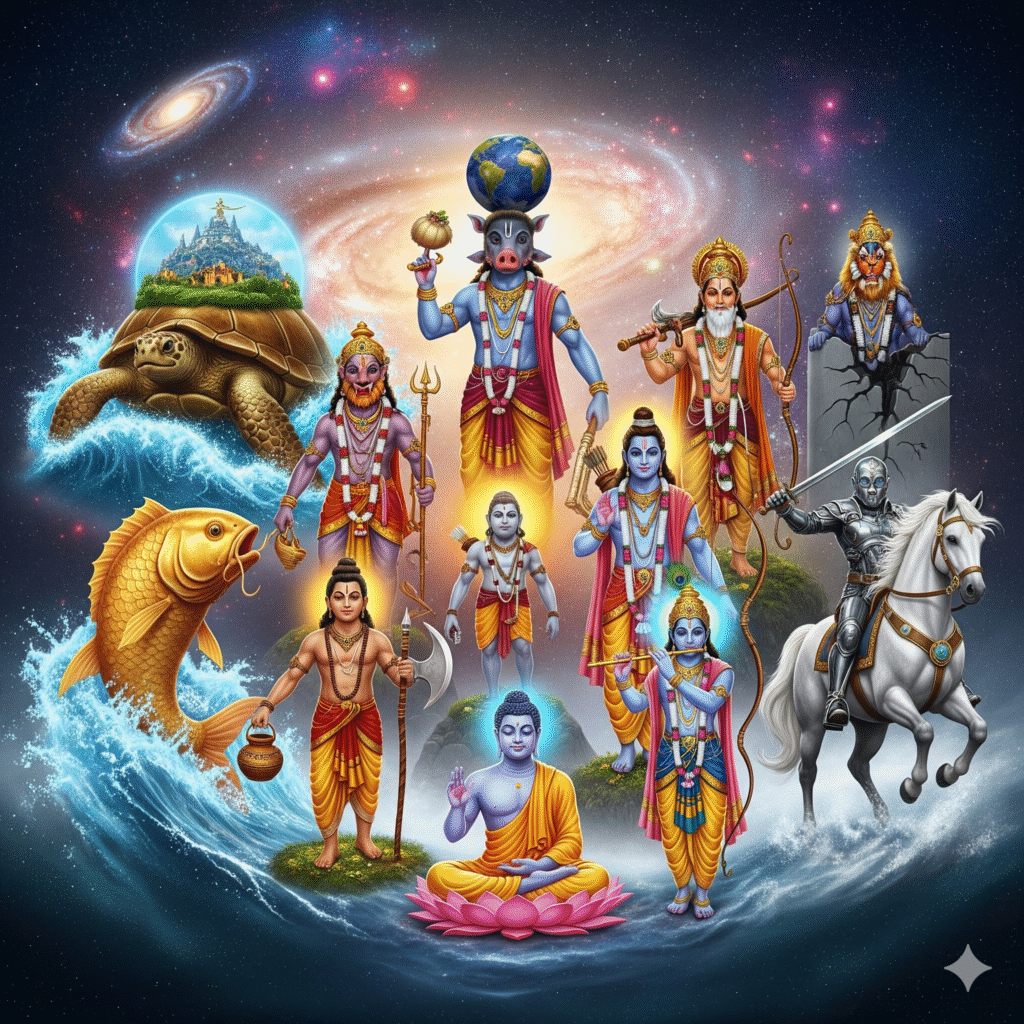
1.Matsya Avatar
The first incarnation of Lord Vishnu is called Matsya Avatar. In this incarnation, he took the form of a giant fish.
According to Hindu scriptures, once when the deluge came, the whole earth was submerged in water. At that time King Manu found a small fish, which urged him to protect it. Manu kept the fish in his vessel, but that fish kept growing bigger. Finally the king understood that this was not an ordinary fish, but Lord Vishnu himself.
In the form of Matsya, Lord Vishnu took King Manu and the Saptarishis to a safe place in a boat and ordered them to start a new creation. He also saved the drowning Vedas and prevented knowledge from being destroyed.
👉 This incarnation teaches us that whenever there is a crisis, God definitely protects his devotees.
2. Kurma Avatar
The second incarnation of Lord Vishnu is called Kurma Avatar. In this incarnation, he took the form of a tortoise.
According to the Puranas, when the gods and demons decided to churn the ocean, Mount Mandara was made the churning rod. But the mountain started sinking in the ocean and churning became impossible.
Then Lord Vishnu entered the ocean in the form of a giant tortoise and supported Mount Mandara on his strong back. The mountain became stable on his back and the Samudra Manthan was successfully completed.
Amrit, Lakshmi, Kaustubh Mani, Airavat elephant, and many divine gems appeared from Samudra Manthan. Due to this nectar, the gods attained immortality.
👉 Kurma Avatar gives the message that when the task seems difficult and impossible, then every task can be successful with patience and stability.
3. Varaha Avatar
The third incarnation of Lord Vishnu is called Varaha Avatar. In this incarnation, he took the form of a giant boar.
According to the Puranas, a demon named Hiranyaksha took the Earth to the netherworld and drowned it in the deep waters of the ocean. When the gods and sages prayed, Lord Vishnu incarnated as Varaha.
He assumed a sky-high form, whose roar shook all the three worlds. In the form of Varaha, the Lord entered the ocean and lifted the Earth on his teeth (danti) and placed it in its place.
After this, he killed Hiranyaksha in a fierce battle and freed the world from his tyranny.
👉 Importance of Varaha Avatar
- This incarnation symbolizes the protection of the earth.
- Gives the message that whenever unrighteousness and tyranny dominate the earth, then God himself incarnates and establishes balance.
4. Narasimha Avatar
The fourth incarnation of Lord Vishnu is called Narasimha incarnation. In this incarnation, he took the form of half lion and half human.
According to the story, a demon named Hiranyakashipu had obtained such a boon by performing severe penance that he could not be killed by either a human or an animal; neither during the day nor at night; neither inside the house nor outside; neither with a weapon nor with a weapon. On the strength of the boon, he spread terror in all the three worlds.
Hiranyakashipu’s son Prahlad was an ardent devotee of Lord Vishnu. When Hiranyakashipu repeatedly tried to stop him from Vishnu-bhakti and troubled him, then Lord Vishnu appeared to protect his devotee.
He appeared in the form of Narasimha at dusk (neither day nor night), at the palace gate (neither inside the house nor outside). He made Hiranyakashipu sit on his thigh and killed him with his nails. In this way, the Lord ended the evil without breaking the conditions of the boon.
👉 Importance of Narasimha Avatar
- This avatar symbolizes the protection of the devotee and the destruction of evil.
- It teaches that no matter how difficult the circumstances are, God himself protects the true devotee.
5. Vamana Avatar
The fifth incarnation of Lord Vishnu is called the Vamana incarnation. In this incarnation, he took the form of a dwarf Brahmin (Vaman).
According to the legend, in Treta Yuga, King Bali had taken over the three worlds with his penance and valour. He was a generous and righteous man, but the gods began to fear his supremacy. Then Lord Vishnu took the Vamana incarnation and went to King Bali to ask for alms.
In the Vamana form, he asked King Bali for three steps of land as donation. King Bali gladly accepted. Then Lord Vishnu appeared from Vamana in the form of the huge Trivikram.
- In the first step, he measured the earth.
- In the second step, he measured the heaven.
- When there was no space left for the third step, King Bali bowed his head, and the Lord placed his third step on his head.
Pleased with the dedication and devotion of King Bali, Lord Vishnu made him the lord of Patala Loka and promised to remain as its gatekeeper forever.
👉 Importance of Vamana Avatar
- This avatar symbolizes the destruction of arrogance and ego.
- It teaches that God’s grace is attained only through devotion and humility.
6. Parashurama Avatar
The sixth incarnation of Lord Vishnu is called Parashuram incarnation. In this incarnation, he took the form of a Brahmin warrior. He always had a Parashu (axe) in his hand, due to which he got the name Parashuram.
According to the story, in Treta Yuga, when the Kshatriya kings started committing atrocities and started destroying religion by misusing their power, then Lord Vishnu took birth in the form of Parashuram.
Parshuram ji killed the tyrannical Kshatriyas 21 times through his penance and strength and freed the earth from their injustice.
He was extremely brave, religious and a devotee of his Guru.
Importance of Parashuram ji
- He was endowed with both Brahmin and Kshatriya qualities.
- He always protected religion and destroyed unrighteousness.
- He is considered an immortal incarnation and it is believed that Parashuram ji will teach the art of weapons to Kalki avatar.
👉 Message of Parashuram Avatar
This avatar teaches us that no matter how strong the injustice and unrighteousness may be, in the end, Dharma and justice always prevail.
7. Lord Rama
The seventh incarnation of Lord Vishnu is called Lord Rama. This incarnation took place in Treta Yuga. Lord Rama is called Maryada Purushottam because he always followed religion and dignity in life.
Lord Rama was born in Ayodhya as the son of King Dasharath and Mother Kaushalya. His brothers Laxman, Bharat and Shatrughan were also born with him.
Major deeds of Lord Rama
- He went with Rishi Vishwamitra and killed many demons.
- He broke the bow of Lord Shiva in Mithila and married Mother Sita.
- During exile, he lived in the forest for 14 years with Mother Sita and brother Laxman.
- When Mother Sita was abducted by Ravana, he attacked Lanka with the help of monkey king Sugriva and devotee Hanuman.
- Lord Rama established religion and justice by killing Ravana.
Importance of Lord Rama
- He is the symbol of ideal son, ideal brother, ideal husband and ideal king.
- His life is exemplary for human society.
- His story is described in detail in Ramayana.
👉 Message of Ram Avatar
This avatar teaches us that a person who walks on the path of truth and dharma ultimately wins despite difficulties.
8. Lord Krishna
The eighth incarnation of Lord Vishnu is called Lord Krishna. This incarnation took place in Dwapar Yuga. Lord Krishna is considered to be the perfect man and Yogeshwar.
He was born in the prison of Kansa in Mathura. Mother Devaki and father Vasudev were his parents. Immediately after birth, Vasudev ji took him to Gokul, where he was brought up by Nandbaba and Yashoda Mata.
Major Leelas of Lord Krishna
- In his childhood, he killed demons like Putana, Trinavarta, Aghasur.
- By lifting Govardhan mountain, he destroyed the ego of Indradev and gave protection to the people of Braj.
- Fascinated the gopis and devotees with the sweet sound of his flute.
- Freed the people from oppression by killing Kansa.
- Gave the sermon of Bhagwad Gita to Arjun in the Mahabharata war, in which the importance of karma, devotion and knowledge was explained.
Importance of Lord Krishna
- He is a wonderful confluence of religion, ethics and love.
- He taught that the biggest duty in life is to follow the duty and protect the religion.
- The teachings of the Gita are still an invaluable text for life guidance.
👉 Message of Krishna Avatar
This avatar teaches that a person who follows the path of devotion and religion always receives the grace of God and gets true success in life.
9. Buddha Incarnation
Lord Buddha is considered to be the ninth incarnation of Lord Vishnu. This incarnation took place at the beginning of Kaliyuga. Lord Buddha was born in Lumbini (Nepal) to King Shuddhodhan and Queen Mayadevi. His childhood name was Siddhartha Gautam.
Life story of Lord Buddha
Even while living in the palace, Siddhartha’s mind was not satisfied with worldly pleasures. When he went out and saw old age, illness and death, he realized the truth of life. He left the palace and did rigorous penance and attained enlightenment under the Peepal tree in Bodh Gaya. Then he was called Gautam Buddha.
Purpose of Buddha incarnation
- To give the message of non-violence, compassion and kindness.
- To inspire people to follow the path of truth and religion by showing kindness to living beings.
- To preach living a peaceful life by staying away from violence and oppression.
Importance of Buddha incarnation
- Lord Buddha is called the “Messenger of World Peace”.
- His teachings led to the establishment of Buddhism, which has spread all over the world today.
- His main message was – “Be your own lamp” i.e. attain enlightenment.
👉 Message of Buddha Avatar
This avatar teaches us that true religion lies in non-violence, compassion and truth.
10. Kalki Avatar
The tenth and last incarnation of Lord Vishnu is called Kalki Avatar. This incarnation is yet to happen and it is believed to appear at the end of Kali Yuga.
Prophecy of Kalki Avatar
According to the Puranas and scriptures, when Adharma, sin, injustice and violence will reach their peak in Kali Yuga and Dharma will almost vanish from the world, then Lord Vishnu will take the Kalki avatar.
He will appear riding a white horse and will have a flaming sword in his hand.
At that time he will destroy the adharmis and the wicked and will re-establish Dharma and truth.
Significance of Kalki Avatar
- This avatar symbolizes the complete end of evil.
- It shows that no matter how much Adharma increases, ultimately Dharma triumphs.
- The new Satya Yuga (Satyug) will begin with the Kalki avatar.
👉 Message of Kalki Avatar
This avatar teaches us that no matter how difficult the times are, God will definitely protect Dharma and the end of Adharma is certain.
Worship and Importance of Lord Vishnu
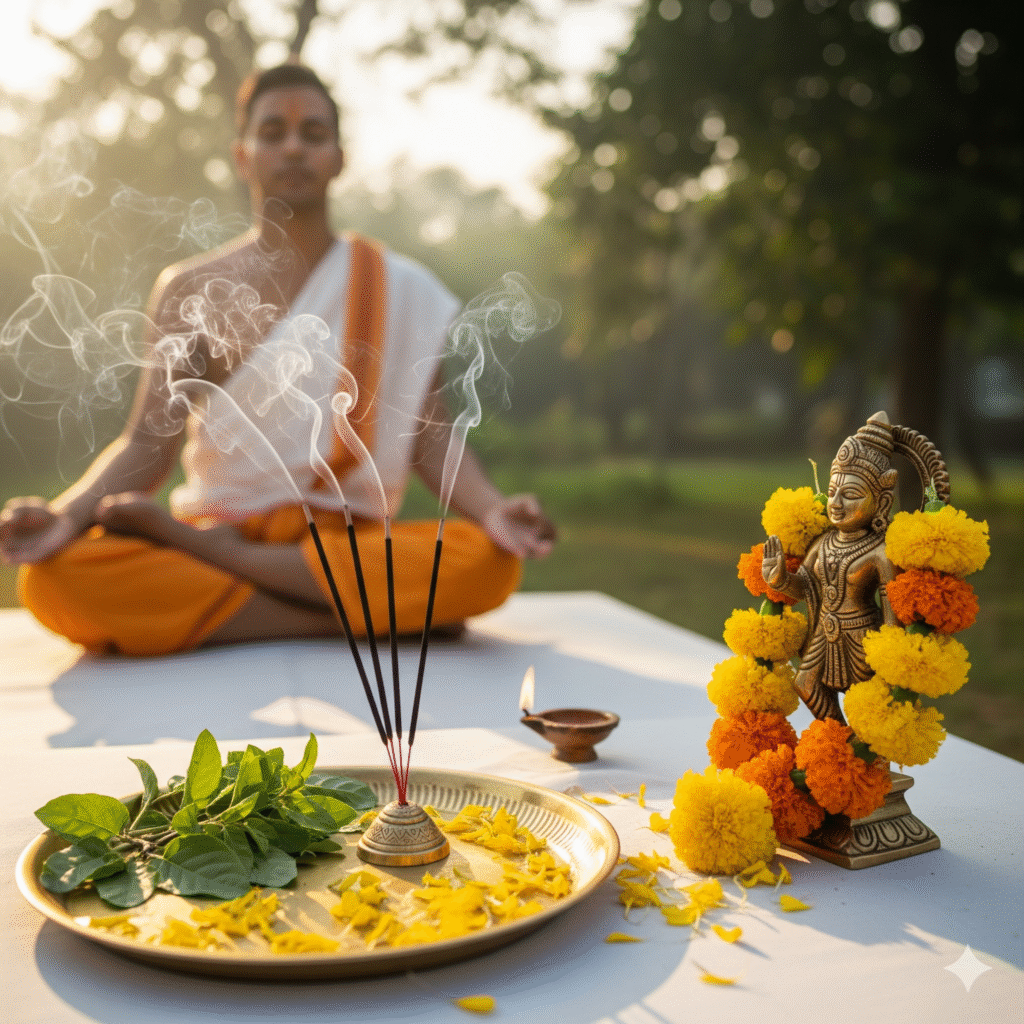
Method of worship of Lord Vishnu
Lord Vishnu is worshipped in a very simple and devotional manner.
- After bathing in the morning, one should wear clean clothes and light a lamp in front of the idol or picture of Vishnu ji.
- Offering yellow flowers, basil leaves, sandalwood and incense is considered especially fruitful.
- Reciting Vishnu Sahasranama, Vishnu Stuti, Narayan Kavach or Bhagvad Gita is considered very auspicious.
- Thursday is considered special for the worship of Lord Vishnu.
Importance of Vishnu Puja
- Lord Vishnu is called the saviour, hence worshipping him brings happiness, prosperity, peace and satisfaction in life.
- By the grace of Vishnu ji, love, harmony and happiness remain in the family.
- Devotees who have Graha Dosha or family difficulties in their Kundali get relief by worshipping Vishnu ji.
- Worshiping with Tulsi leaves destroys all sins and gives salvation.
Spiritual significance
Worshiping Lord Vishnu teaches us that the world is governed by Dharma and balance. His message is –
- Maintain patience and balance in life.
- No matter how strong the evil is, in the end Dharma and truth prevail.
- Devotion to Vishnu purifies the soul and leads us to salvation.
👉 Thus, worshiping Lord Vishnu not only brings happiness and prosperity in material life, but also brings peace and wisdom in spiritual life.
Method of Worship of Vishnu Ji
Time and place of worship
- The best time to worship Lord Vishnu is considered to be morning and evening.
- While worshiping, the place should be clean, calm and full of positive energy.
- It is auspicious to place the idol or picture of Vishnu Ji in the north-east direction (Ishaan angle).
Required materials
- Clean water and Gangajal
- Yellow or white flowers
- Tulsi leaves (offer directly without touching)
- Sandalwood and Akshat
- Lamp and incense
- Yellow fruits and Prasad (bananas, Motichoor laddus etc.)
Procedure of worship
- Take a bath in the morning and wear clean yellow clothes.
- Light a lamp and incense at the place of worship.
- Sprinkle Gangajal on the idol or picture of Lord Vishnu.
- Offer sandalwood, Akshat, flowers and Tulsi leaves.
- Chant Vishnu Sahasranama, Narayan Stuti or “Om Namo Bhagwate Vasudevay” mantra.
- Finally offer fruits, sweets and prasad and perform aarti.
Significance of Puja
- Worshiping Vishnu Ji brings wealth, happiness and peace in the house.
- Offering Tulsi leaves destroys sins and leads to attainment of virtue.
- Planetary defects, family feuds and financial difficulties are removed.
- Prosperity and salvation are attained by the grace of Vishnu Ji.
👉 Thus, the method of worshiping Lord Vishnu is simple yet very effective. Regular worship removes all kinds of obstacles in life and paves the way for happiness and prosperity.
Importance of Vishnu Ji
The protector of the universe
Lord Vishnu is considered the protector. He maintains the order of the universe and protects all living beings. Brahma creates the universe, Shiva destroys it, while Vishnu nurtures and protects the world.
Protection of Dharma
Whenever adharma increases on earth, Lord Vishnu re-establishes Dharma by appearing in the form of his Dashavataras. In this way, he always protects Dharma, truth and justice.
Happiness and prosperity in life
Worshiping Vishnu Ji brings wealth, happiness and peace in life. His blessings make the home and family prosperous and harmonious.
Attainment of salvation
By remembering the feet of Lord Vishnu, man gets freedom from the bondage of birth and death. He gives the blessings of salvation and improvement in the afterlife to the devotees.
Symbol of balance and compassion
The form of Vishnu Ji is a symbol of compassion, kindness and balance. He teaches that real peace and stability can be achieved only by following the path of Dharma in life.
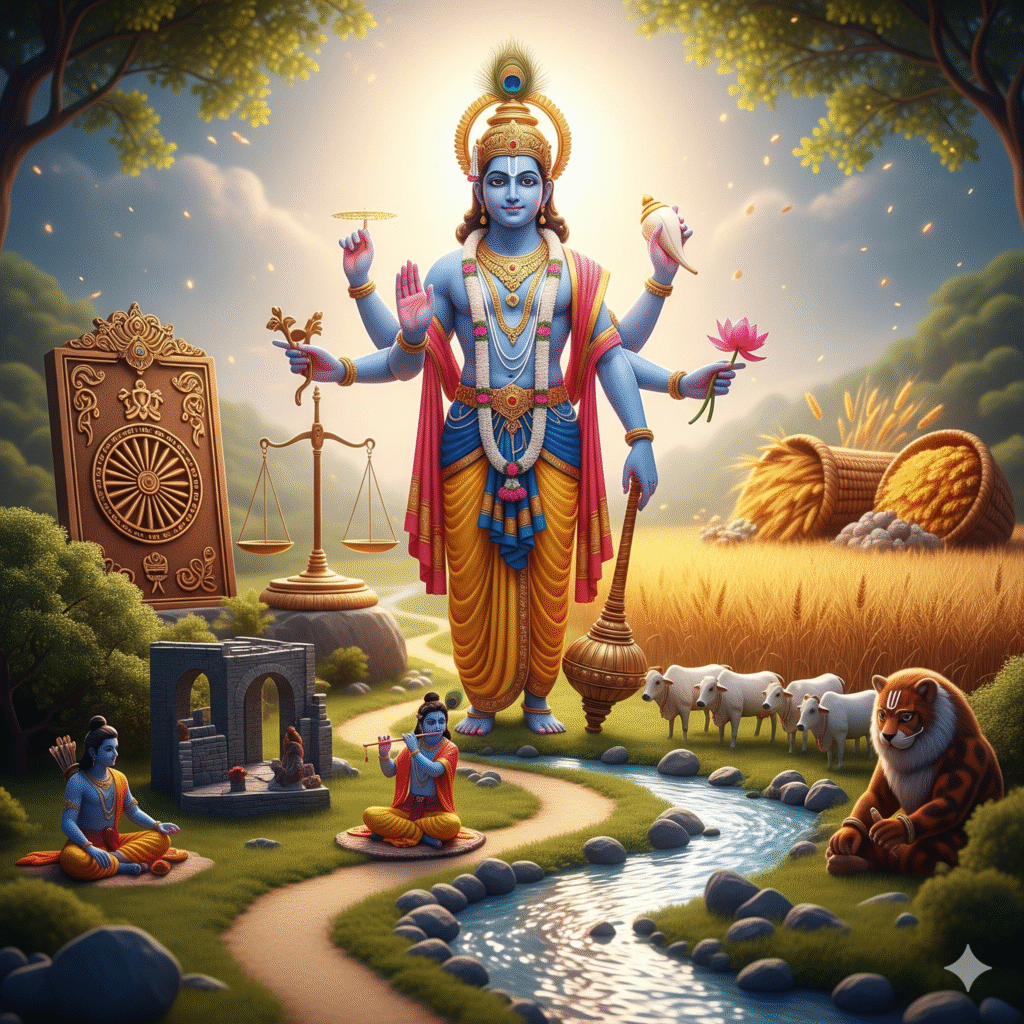
Conclusion
Lord Vishnu is considered the preserver of the universe and protector of Dharma in Hinduism. His Dashavatara makes it clear that he appears on earth from time to time to destroy evil and establish Dharma.
Worshiping Vishnu Ji brings peace, prosperity, happiness and salvation in life. He is a symbol of compassion and balance, who teaches us that true life is the one that walks on the path of Dharma, truth and goodness.
👉 Therefore, worshiping Lord Vishnu is not only a religious duty but also a path to spiritual advancement and success in life.
References
- Rigveda, Yajurveda and Samveda – description of the form and qualities of Lord Vishnu.
- Bhagvad Gita – establishment of religion by Lord Vishnu (in the form of Krishna) and the importance of Karma Yoga.
- Shrimad Bhagwat Purana – detailed description of the Dashavatara and Leela of Lord Vishnu.
- Ramayana – story of Lord Vishnu’s Rama avatar.
- Mahabharata – role and teachings of Lord Vishnu in Krishna avatar.
- Vishnu Purana – detailed description of the worship, importance and form of Lord Vishnu.
- Acharya Ramchandra Shukla, essays on Hindi literature and religious texts.
- Dr. Satyavrat Shastri, Indian religion and culture.